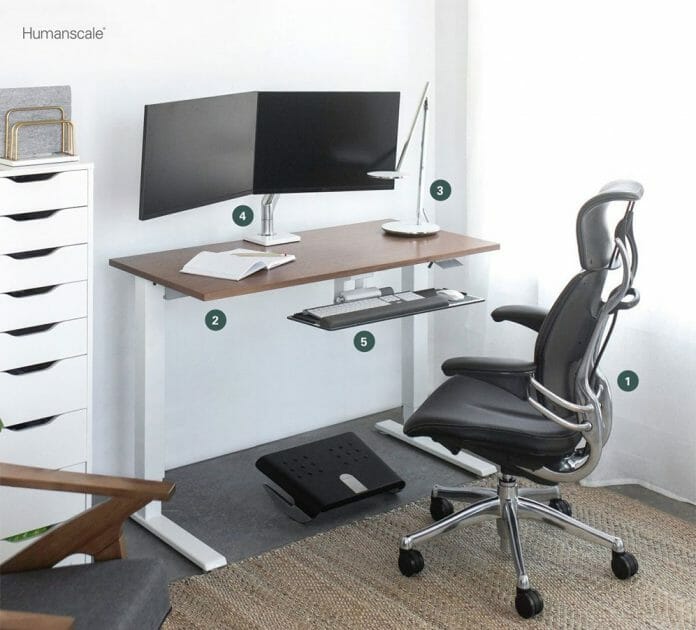With rising cases of Covid-19 infection and impending further CMCO’s in the cities, businesses are encouraging staffers to continue working from home in efforts to keep them safe and be productive at the same time. While the order can be somewhat encouraging, but it does come with other health risks, for instance “is our homes build to be conducive for working?”
This is where furniture makers step in, Humanscale has been involved in workspace design for over 35 years and they have a team of certified ergonomists who now only make beautiful chair and desk but also its function on our backs.
In this aspect they have come up with 5 essential factors to consider before one starts the prospects of working from home, as the hours could be similar or even longer ensuring a workstation is functional and adaptable, as well as comfortable and healthy is crucial. Here’s a checklist.
1. The Chair
Finding the perfect task chair is an important first step when creating a healthy comfortable workspace. Jonathan Puleio, a certified ergonomist and Global VP of Consulting for Humanscale, is focused on the correlation between a person’s comfort while working and their overall experience. He suggests that a comfortable ergonomic chair can lead to an increase in alertness as well as an increase in blood flow, benefitting a person’s well-being. “A good task chair can provide you with the best possible foundation to create great work,” he says. Puleio suggests looking for a chair that automatically adjusts to the sitter so they don’t need to fumble with confusing knobs and levers to be comfortable as they change tasks and positions throughout the day. Any adjustments that aren’t automatic, such as height and armrest height, should be easy and intuitive. One chair Puleio recommends is Humanscale’s Liberty chair which, like all Humanscale chairs, offers a self-adjusting weight sensitive recline with a pivoting backrest that provides lumbar support for all sitting positions.
2. The Desk
For decades, office furniture was designed to be stationary and people were required to adjust their physical positions around the tools in their workstation. Ergonomists now know that it’s important for people to be able to move freely throughout the day in order to be healthy, comfortable and focused at work. Furniture should adjust to the professional using it, not the other way around. Committed to putting people first, Humanscale designs all of its furniture, including desks, to move with the user as they work. A good sit/stand desk should be simple, intuitive and easy to use, so if a person needs to stand or sit while working, the process of raising or lowering the desk is seamless. Humanscale’s Float desk, for example, has an integrated counterbalance mechanism that accommodates varying weight loads. So with the press of a streamlined lever under the work surface, raising or lowering the desk is as quick and easy as sitting or standing and doesn’t interrupt the workflow.
3. The Lighting
Natural light in the workplace is widely recognized as a positive influence on productivity, creativity, and mood, but is just one of many light sources needed to fully address wellbeing at work. With the rise of backlit screens and open floor plans, task lighting, as a supplement to natural or overhead lighting, is necessary for an optimal work experience. “To avoid ocular discomfort that can negatively impact one’s performance as well as their overall health and wellbeing, it’s important to find proper task lighting that casts a wide footprint, is glare-free and offers a single shadow and that is smooth and easy to adjust as needs shift throughout the day,” says Puleio. The adjustments a task light should be able to perform include both manual positioning and brightness levels. Humanscale’s Horizon 2.0 is one task light that meets these needs. It reduces eye strain and improves overall comfort by providing glare-free light that intuitively adjusts for a range of activities, from reading documents to writing emails, and everything in between.
4. The Monitor Arm
Though often overlooked, monitor arms promote a clutter-free workspace and support a healthier, more ergonomic working posture, making it a must-have for the ideal desk setup. Many professionals tend to lean in toward their computer monitor in order to see it better, whereas monitor arms enable them to pull the monitor closer so they can sit in a healthy posture, with their back against the back of the task chair, and still see the work on their screen. Users are encouraged to align the monitor at the correct height for them, which helps to prevent eye and neck strain. Monitor arms are also key for professionals that utilize multiple monitors to manage their work.
5. The Keyboard Tray
A keyboard tray is another vital tool that helps achieve an adapting, ergonomic workspace. This underrated tool brings the keyboard and mouse closer and encourages professionals to sit in a healthy, neutral posture without leaning forward. A well-designed keyboard tray offers protection from carpal tunnel syndrome, neck and back pain and other musculoskeletal issues. Other ergonomic tools, including Humanscale’s NeatTech, NeatUp and NeatLink, help to keep the desktop clear of cables and clutter.
With each of these tools working in harmony to provide ergonomic support and comfort, anyone can have a “perfect” workstation.
Available at XTRA Furniture Garden Midvalley









